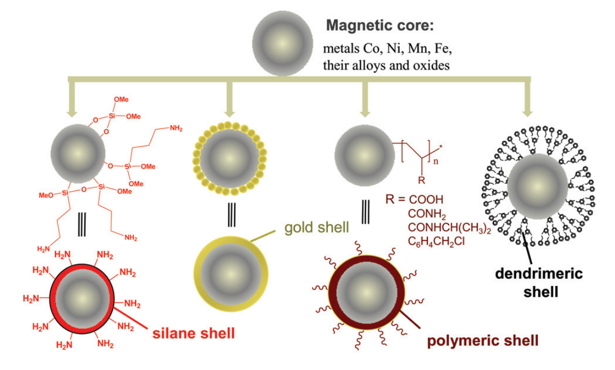Properties and Applications of Magnetic Nanoparticle

Introduction
Magnetic nanoparticles are nanomaterials composed of magnetic elements (such as iron, nickel, cobalt, chromium, manganese, and gadolinium) and their compounds. Magnetic nanoparticles are superparamagnetic because of their nanoscale size, offering great potential in a wide variety of applications, either in bare form or with surface coatings and functional groups selected for specific applications. In particular, ferrite nanoparticles are the most explored magnetic nanoparticles, and their magnetic properties can be greatly increased by aggregating many individual superparamagnetic nanoparticles into clusters to form magnetic beads.
Magnetic nanoparticles can be selectively attached to functional molecules and allow transport from electromagnets or permanent magnets to target sites under an external magnetic field. Surface coatings may be required to prevent aggregation and minimize particle interaction with the system environment. The surface of ferrite nanoparticles is usually modified with surfactants, silica, organosilicon or phosphoric acid derivatives to increase their stability in solution. Overall, coated magnetic nanoparticles have been widely used in medical applications such as cell separation, immunoassays, diagnostic tests, and drug delivery.

Figure 1: Various application directions of magnetic nanoparticles
Properties of Magnetic Nanoparticles
1. Magnetic
The properties of magnetic nanoparticles depend on their synthesis method and chemical structure. In most cases, magnetic nanoparticles range in size from 1 to 100 nanometers and can display super para-magnetism. Super para-magnetism is induced by thermal effects, and thermal fluctuations are strong enough to spontaneously demagnetize previously saturated assemblies; thus, these particles have zero coercivity and no hysteresis. In this state, the external magnetic field can magnetize the nanoparticles with large magnetic susceptibility. When the magnetic field is removed, the magnetic nanoparticles do not exhibit magnetization. This property can be used for controlled therapy and targeted drug delivery.
2. Magnetocaloric Effect
Some magnetic materials heat up when placed in a magnetic field and cool when removed from it, a phenomenon known as the magnetocaloric effect (MCE). Magnetic nanoparticles offer a promising alternative to traditional bulk materials due to their size-dependent superparamagnetic properties. Furthermore, the large surface area in magnetic nanoparticles has the potential to provide better heat exchange with the surrounding environment. Through the careful design of the core-shell structure, it will be possible to control the heat exchange between the magnetic nanoparticles and the surrounding matrix, which provides a possible way to improve therapeutic techniques such as hyperthermia.
Application Direction of Magnetic Nanoparticles
1. Magnetic Separation
In biomedical research, the isolation of specific molecules, including DNA, proteins, and cells, is a prerequisite for the development of biotechnology in most areas of the biological sciences. Among various bio-separation methods, magnetic nanoparticles provide assurance for the unique magnetic separation effect and promising efficiency-based bio-separation, which is the most documented and widely used. In this process, biomolecules are colloidally labeled with magnetic nanoparticles and then separated under the action of an external magnetic field, which can be applied to cell separation, protein purification, RNA/DNA extraction, immunoprecipitation and other fields.

Figure 2: Schematic diagram of the application mechanism of magnetic separation in biomedicine
Magnetic nanoparticles such as magnetic beads have been widely used in the separation and purification of cells and biomolecules due to their small size, good separation effect, and good dispersibility. One of the trends in this discipline is the use of magnetic bead-coupled.Antibodies are magnetically separated to provide highly precise antibodies that can specifically bind to matching antigens on the surface of the target site.
2. Diagnosis
By labeling stem cells with magnetic nanoparticles, a non-invasive imaging method has been developed. Among them, magnetic resonance imaging (MRI) is widely used as a diagnostic tool to visualize the structure and function of tissues with high spatial resolution and great anatomical detail. Several magnetic nanoparticles have been developed to improve contrast agents in MRI imaging, with significant advantages of increased sensitivity, good biocompatibility, and easy detection at moderate concentrations.
3. Sensor
Due to their unique magnetic properties, many magnetic nanoparticle-based biosensors have been surface-functionalized to recognize specific molecular targets, which are absent in biological systems. Due to their different compositions, sizes, and magnetic properties, magnetic nanoparticles can be used in various instruments and forms of biosensing with enhanced sensitivity and stability.
4. Drug Delivery
Magnetic nanoparticles have been developed and applied for local drug delivery in tumors. Magnetic nanoparticles are firstly used as drug carriers, attached to the outer surface of the drug or dissolved in the coating. Once the drug-coated particles are introduced into the patient's bloodstream, strong permanent magnets create a magnetic field gradient that retains the particles in the targeted area. Furthermore, drug-coated magnetic nanoparticles can be injected intravenously, transported, and retained at the target site, making them very promising drug delivery systems.

Figure 3: Schematic diagram of magnetic nanoparticles with different shells
5. Treat
Magnetic nanoparticles are currently being explored as a technique for heating tumors in targeted therapy, known as hyperthermia. Different types of superparamagnetic nanoparticles have different coatings and targeting agents for specific tumor sites. Magnetic particle heating can be done at the depth needed to treat tumors in almost any location in the body. In addition, magnetic nanoparticle hyperthermia can also be used as an adjunct to conventional chemotherapy and radiotherapy, showing great potential.
Figure 4: Structural diagram of magnetic nanoparticles for tumor therapy
References
1. C. Buzea, I. Blandino, K. Robbie, Biointerphases, 2007, 4, 17-172. 10.1116/1.2815690
2. R. Rikken, R. Nolte, J. Maan, D. Wilson, P. Christianen, Soft Matter, 2014, 10, 1295-1308. 10.1039/C3SM52294F
3. A. Giustini, A. Petryk, S. Cassim, J. Tate, P. Hoopes, Nano Life., 2010 . 10.1142/S1793984410000067
4. E. Bull, S. Madani, R. Sheth, A. Seifalian, M. Green, AM Seifaliam, Int J Nanomedicine. 2014, 9, 1641-1653. https://hal.science/hal-03136031/document
5. L. Li, W. Jiang, K. Luo, H. Song, F. Lan, Y. Wu, Z. Gu, Theranostics., 2013, 3, 595-615. 10.7150/ thno.5366

